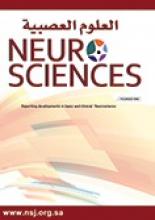Abstract
OBJECTIVE: To evaluate the diagnostic yield, accuracy, and safety of frame-based stereotactic brain biopsy procedures.
METHODS: A retrospective study of all pathologically diagnosed intracranial lesions, using frame-based stereotactic guided brain biopsy procedures performed at King Faisal Specialist Hospital and Research Centre (KFSH&RC), Riyadh, Kingdom of Saudi Arabia between 1993 and 2005 was conducted. Medical charts, radiological studies, and pathological slides were reviewed.
RESULTS: A total of 120 consecutive patients who had frame-based stereotactic diagnostic biopsy procedures were identified. Data regarding procedural techniques, lesion locations, pathological diagnosis, and postoperative complications were collected. Patients’ ages ranged from 3-72 years (mean +/- standard deviation: 39.4 +/- 20.3), 67 males and 53 females. Sites of biopsied lesions included: 49 thalamic, 29 deep frontal, 23 parietal, 9 temporal, and 10 others. Targeting accuracy was 99.2%. General anesthesia was used in 103 patients (85.8%). The rest was carried out under local anesthesia. Diagnostic yield was estimated at 96%. Most frequently encountered pathological diagnosis includes gliomas (63%), infections (16%), and lymphomas (7%). One mortality (0.8%), and 5 (4%) morbidities were encountered.
CONCLUSION: Stereotactic brain biopsy is a relatively safe technique to obtain a tissue biopsy that represents the pathology of the lesion. Recent advances in stereotactic neurosurgical techniques have helped to improve the safety and diagnostic yield of such procedures.
- Copyright: © Neurosciences
Neurosciences is an Open Access journal and articles published are distributed under the terms of the Creative Commons Attribution-NonCommercial License (CC BY-NC). Readers may copy, distribute, and display the work for non-commercial purposes with the proper citation of the original work.






